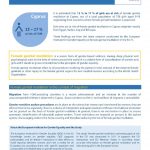Cyprus
- Australia
- Benin
- Brunei
- Burkina Faso
- Cameroon
- Canada
- Central African Republic
- Chad
- Colombia
- Côte d’Ivoire (Ivory Coast)
- Denmark
- Djibouti
- Egypt
- Eritrea
- Ethiopia
- France
- Germany
- Ghana
- Guinea
- Guinea-Bissau
- Indonesia
- India
- Iran
- Iraq
- Ireland
- Jordan
- Kenya
- Kuwait
- Liberia
- Malawi
- Malaysia
- Mali
- Malta
- Mauritania
- Mexico
- Niger
- Nigeria
- Oman
- Pakistan
- Peru
- Portugal
- Russia
- Saudi Arabia
- Senegal
- Sierra Leone
- Singapore
- Somalia
- Somaliland
- South Sudan
- Spain
- Sudan
- Sweden
- Switzerland
- Tanzania
- Thailand
- The Gambia
- The Maldives
- Togo
- Uganda
- United Arab Emirates
- United Kingdom
- United States of America
- Yemen
- Zambia
- Zimbabwe
Population
1.2 million (2019)
2019 population growth rate
0.02%
Estimated prevalence among girls and women
Unknown.
Between 12% – 17% of girls from countries that practice female genital cutting (FGC) and living in Cyprus, out of a total population of 758 girls (0-18 years old), are at risk. So far, it is known to be practised mostly among refugee women coming from Egypt, Sudan, Iraq, Ethiopia.
Source: The European Institute of Gender Equality
Legal status
FGC is illegal in Cyprus. It was incorporated in the Criminal Code in 2003, and is punishable with up to 5 years of imprisonment. The government has applied the principle of extraterritoriality to ensure that if girls undergo FGC when they go back to their home country, the crime will be prosecuted in Cyprus.
Cyprus ratified the Istanbul Convention in July 2017 – the Council of Europe Convention on preventing and combating violence against women and domestic violence. General child protection provisions can be used in cases of FGC, holding parents accountable.
The Refugee Law 2009 within Cyprus can be used to grant asylum to women and girls who have undergone FGC and who are in danger of going through it.
Source: The European Institute for Gender Equality
Progress to end FGC
- Although a number of girls are at risk of FGC, communities are gradually moving away from the practice, because of integration efforts and laws.
- Research has shown that men and women from FGC practising countries have reported that their attitude towards the practice has changed after migrating to Europe. They are exposed to new information about the practice, laws against it, and its damaging effects on sexual and reproductive health.
Source: The European Institute for Gender Equality
History
Women and girls from refugee and migrant community in Cyprus are thought to be affected by cutting, particularly from Egyptian, Sudanese, Iraqi, and Ethiopian communities.
Human Development Index ranking
Rank 32
Infant mortality rate
2.6 deaths per 1,000 live births
Maternal mortality rate
2.1 deaths per 100,000 live births


